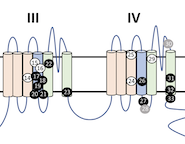Abstract
Pathogenic variants in the CACNA1A gene have been associated with episodic ataxia type 2, familial hemiplegic migraine, and spinocerebellar ataxia 6. With increasing use of clinical genetic testing, associations have expanded to include developmental delay, epilepsy, paroxysmal dystonia, and neuropsychiatric disorders. We report 47 individuals with 33 unique likely pathogenic or pathogenic CACNA1A variants. A machine learning method, funNCion, was used to predict loss-of-function (LoF)/gain-of-function (GoF) impact of genetic variants, and a heuristic severity score was designed to analyze genotype/phenotype correlations. Commonly reported phenotypes include developmental delay/intellectual disability (96%), hemiplegic migraines (36%), episodic ataxia type 2 (32%), epilepsy (55%), autism spectrum disorder (23%), and paroxysmal tonic upward gaze (36%). Severity score was significantly higher for predicted GoF variants, variants in the S5/S6 helices, and the recurrent p.Val1392Met variant. Seizures/status epilepticus were correlated with GoF and were more frequent in those with the p.Val1392Met variant. Our findings demonstrate a breadth of disease severity in CACNA1A-related disease and suggest that the clinical phenotypic heterogeneity likely reflects diverse molecular phenotypes. A better understanding of the natural history of CACNA1A-related disease and genotype/phenotype correlations will help inform prognosis and prepare for future clinical trials.
